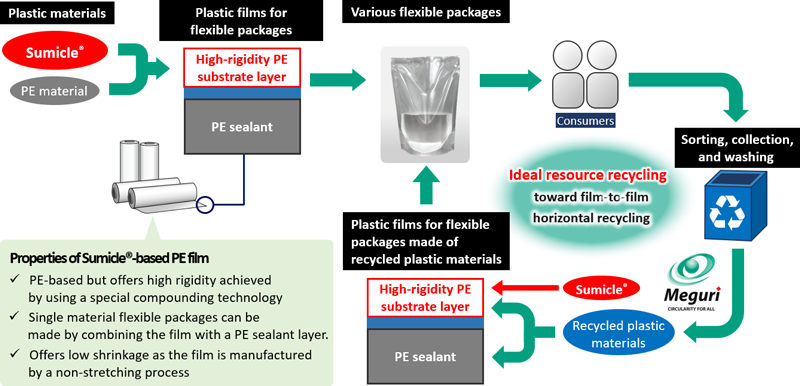Social Issues addressed by Sumitomo —Compass for the Future—
Development of a new polyethylene that can be the sole resin material for flexible packages promises to make horizontal recycling of plastic products practicable
 Planetary Health
Planetary HealthIn a world in which companies are stepping up their initiatives in pursuit of carbon neutrality, one of the basic policies of Sumitomo Chemical’s corporate business plan for fiscal 2022 to fiscal 2024 is to fulfill obligations and provide contributions toward achieving carbon neutrality. In terms of its obligations, the company has set quantitative targets to reduce its Scope 1 and 2 greenhouse gas (GHG) emissions by 50% compared with fiscal 2013 by 2030 and to attain net zero by 2050. From the perspective of contributions, the company is developing various technologies and products that will help achieve carbon neutrality and its promotion of plastics recycling is part of this endeavor.
In the drive to reach carbon neutrality, it is important to reduce not only the use of fossil-derived resources but also incineration of waste. Initiatives to promote resource recycling by enhancing recyclability of the flexible packages widely used for food and daily necessities contribute to the attainment of both these goals. Moreover, there is growing social demand for the development of easy-to-recycle plastic materials as well as for reduction in the volume of disposable plastic products, not least in Japan where the Plastic Resource Circulation Act of April 2022 gave added impetus to this trend.
Sumitomo Chemical developed Sumicle®, a new polyethylene (PE) for flexible packages in 2022. In view of its potential as a material that can facilitate recycling of plastic products, which had previously been impracticable, Sumicle has become a focus of keen interest. Flexible packages are typically composed of multiple layers, with each layer made of a different type of resin with different characteristics, such as nylon, polyethylene terephthalate (PET), and PE. For example, in the case of packaging for liquid detergent, while nylon or PET is used for the substrate, PE, which is suitable for heat sealing, is used for the sealant layer. The difficulty of sorting and extracting these different types of materials separately means that recycled materials are of lower quality than newly manufactured ones, and so most used flexible packages are incinerated. Although some are cascade recycled into products of lower quality than the original ones, most waste plastics are ultimately incinerated.

Sumicle is a PE with high rigidity achieved by using a novel compounding technology. By applying Sumicle as the substrate layer of flexible packages, for which nylon or PET is conventionally used, and combining it with a PE sealant layer, it is possible to make plastic packaging film only from PE. This enables horizontal material recycling of used flexible packages, which means used plastic products are transformed back into material of a quality level suitable for the same application as the original products. In other words, used plastic packaging film can be recycled as pristine plastic packaging film, which is something that had previously been impracticable.

Horizontal recycling will lead to reduction of plastic waste destined for disposal by incineration as well as reduction in the use of fossil-derived resources. Sumicle’s high rigidity can add strength and realize easy-to-recycle flexible packages made of a single material. Indeed, the numerous inquiries Sumitomo Chemical has received attest to Sumicle’s appeal to the growing ranks of environmentally conscious manufacturers. The company is already providing samples of Sumicle. Positioning Sumicle as a product contributing to promotion of plastics recycling, Sumitomo Chemical aims for early commercialization.


Sumitomo Chemical considers that it should not only develop and manufacture Sumicle but also exercise responsibility after it is used in final products. Therefore, to promote the recycling of Sumicle for the benefit of society, the company will endeavor to construct a system, including the establishment of a sorting and collection scheme for flexible packages. It has established its own brand, Meguri®, for plastic products made using recycling technology, and is considering selling recycled plastics based on materials using Sumicle under the Meguri brand in the future.

